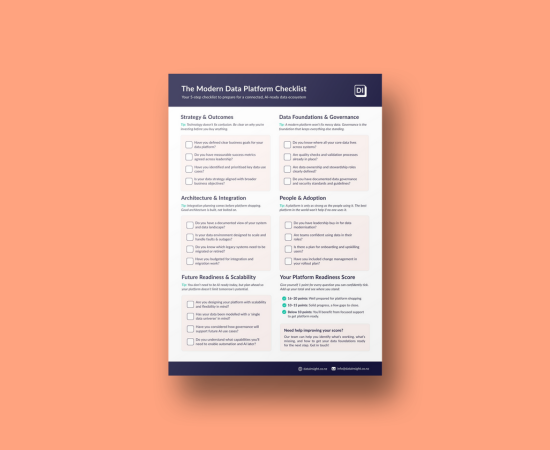This one is for running enthusiasts…
During my recent break in Spain and getting ready for an upcoming marathon in France’s Medoc region, I also happened to be thinking about data strategy.
Why, you ask?
Well, after running many races since 2010, training across thousands of kilometers, and throughout my career working on many projects and helping a range of different organisations to use their data better, I have realised that implementing a data strategy and running a marathon are actually quite similar.
I’ll explain:
1. Know your distance
Before you start your data journey, it’s important to be clear on what your journey is. In other words, the outcomes you want to achieve and the deliverables or steps to get there. While the goal may be to become a fully data-driven organisation, there are basics and foundations to get right and be embedded before you move to more mature data steps such as implementing a data warehouse, self-service analytics, or AI pilots.
It’s the same with running. Before you even start planning your training, you need to decide what distance you want to run. Many professionals recommend not to going straight into a full marathon, but instead starting with a fun run and increasing the distance as your fitness increases.
The key point here is to clearly identify what the end goal is before you map out the journey. This will inform appropriate steps to be taken and the right process to achieve the desired outcome.
2. It is not just about technology, or running
There’s a lot more than technology that goes into a data strategy. Yes, implementing technology is a critical component that any organisation needs to tackle as part of a data strategy. But there are other components such as capability, governance, and processes that also need to be considered as part of a successful data strategy. Indeed, these things will inform what the right technology is, and how it is implemented.
With running, while you may have run some shorter races and feel ready to prepare for your first marathon, there’s a lot more to it than just running further. Just as with data strategy, there are other areas that are important, such as your gear, physiotherapy, nutrition, resting, and hydration.
What it boils down to is preparation. Not just identifying the end goal but carefully outlining the steps, measures and tools that are necessary to be successful in your quest. And that leads onto the next point…
3. You need a plan to get you to the finish line
Having a data strategy is critical. But you also need a roadmap to execute your strategy, which should be based on a maturity assessment that identifies your starting position. Commencing your journey by tackling the easy wins and foundational tasks provides a strong basis to build upon as you progress through to your desired goal. It’s also important to test your assumptions and ideas through the process so you can make refinements to ensure the greatest returns for the organisation.
To ensure you will be able to comfortably complete a marathon, you also need to plan in advance, starting slow and short and steadily increasing the distance and pace. To find your best pace for training and the marathon, you will need to perform an initial test to understand your fitness level. You should also test any gear, nutrition, or hydration.
There’s an old saying that goes “Failing to plan is planning to fail”, and it’s certainly true when executing a data strategy and running a marathon.
4. Get help from the professionals
Enlisting the help of data specialists is always a good approach. They will guide you on best practices and bring insight and experience on what has and hasn’t worked previously. They will steer you in the direction of the best approach to achieve your desired goal, which will ensure your budget, time, and resources are maximised.
With marathon running, it’s also a good idea to have a professional coach create a training plan adapted to your needs, based on their previous experience with similar runners. The same applies with physiotherapist, nutritionists, and shoes specialists, who can recommend you what is best for you.
At the end of the day, it’s still you executing a data strategy or running the marathon, but there is great support and comfort in having a team of professionals backing your success!
5. It’s not all glory
While the glory is in the successful execution of a data strategy that is game changing for your organisation, there are some less exciting, but equally as important parts of the journey. With data strategy, it’s things like data governance and setting the right foundations. Sure, these things may not seem like the most exciting activities to be undertaken, but without them underpinning your data strategy, it is unlikely be a success.
It’s the same with recovery runs, which are usually those that people want to skip and seen as the lowest value. However, they are important and can make a large difference – take professional athlete Eliud Kipchoge as an example; a 2x Olympic marathon winner, world record holder and only human to run under 2 hours in a marathon distance, I bet he never misses a recovery run!
Bottom line? Don’t scrimp on the less exciting steps, they are foundational and integral to successful execution.
6. Set yourself a challenging but achievable target
There may be organisations you admire and whose footsteps you may wish to follow. Having goals is important, as is using the progress of others as a yardstick. However, instead of focusing on what they do (for example using AI algorithms to predict outcomes), which is a result of their unique journey, people, processes, and technology, it’s better to look at your current state and make improvements. Let’s say everyone in your organisation is using different Excel spreadsheets that are manually populated - rather than setting yourself a goal to emulate another organisation that is significantly more mature, find a state that is still a great improvement and puts you on a pathway to greater maturity, but one that is achievable given your current budget and resources.
If I tried to run a marathon at Eliud’s Kipchoge World Record time, I would have to quit after 800 metres. Even if I wanted to qualify for the next Olympics, I would need to improve my personal best by almost an hour, which is pretty unrealistic. However, I can set myself challenging objectives for my next marathon, like improving my PB, which is still a great improvement.
Definitely stretch and challenge yourself but make it measured. Aim for improvement at a pace that is realistic for your situation.
7. The race does not end when you reach the finish line
So, you’ve made it to the finish line. Does this mean you won’t run anymore? Whilst this may be true for some people, usually most will find new objectives to stive for, like improving time on their next marathon, running faster on shorter distances, running a longer distance race like an Ultra or taking on Triathlon.
Similarly with data, once you have achieved the different areas of your strategy such as implementing a new data repository, upskilling the team, and setting up your data governance group, there will be many options for you to keep improving in your data journey. Take pause to reflect on what you have achieved, identify what areas are still challenging, or where there are opportunities to build a new roadmap that sets your organistion higher objectives.









.png)